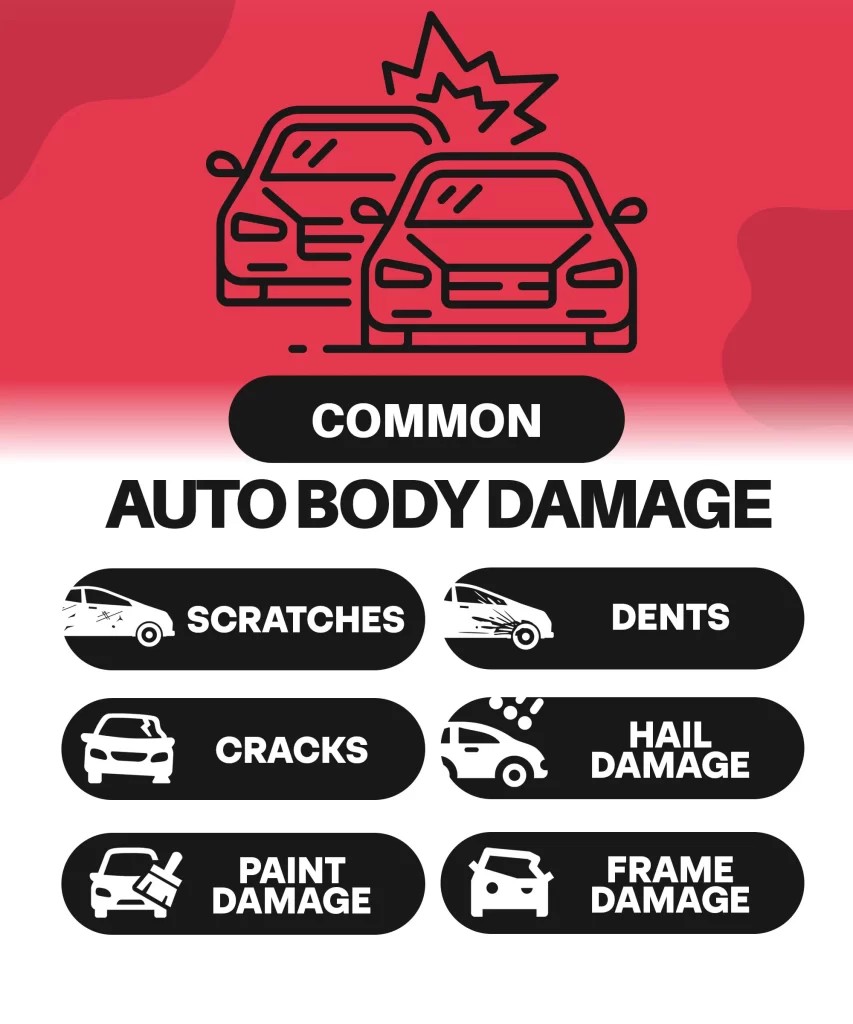Car body damage can be a frustrating experience for any car owner. From minor scratches to significant dents, understanding how to address these issues is crucial for maintaining your vehicle’s appearance, value, and structural integrity. Various auto body repair techniques are available, each designed to tackle specific types and severities of damage, restoring your car to its former glory. Knowing these methods empowers you to make informed decisions about your car’s care.
Understanding the array of auto body repair techniques is essential for choosing the most appropriate method for your vehicle. These techniques range from straightforward fixes like touch-up painting and basic dent removal to more complex procedures like paintless dent repair, frame straightening, and panel replacement. This guide will walk you through common types of car body damage and the repair techniques best suited for each situation.
Understanding Common Types of Car Body Damage
Before diving into how to repair car body damage, it’s important to identify the different types of damage your car can sustain. Recognizing the specific type of damage is the first step in determining the correct repair approach. Here are some of the most common types of auto body damage:
1. Scratches: Surface Level Imperfections
Scratches are perhaps the most common type of car body damage. They are surface marks that occur when the car’s paint is scraped or abraded. Scratches can range from superficial clear coat scratches that are barely noticeable to deeper scratches that penetrate the color coat and even reach the primer or bare metal. Minor scratches often result from brushing against bushes, car washes, or even improper cleaning techniques. Deeper scratches can be caused by keys, road debris, or minor collisions.
2. Dents: Depressions and Deformations
Dents are depressions or deformations in the car’s body panels, usually caused by impact. The severity and type of dent can vary widely. Small, shallow dents, often called “dings,” might be caused by car doors hitting your vehicle in a parking lot or stray shopping carts. Larger, more pronounced dents can result from collisions with other vehicles, animals, or objects. The depth and location of a dent will influence the repair method.
3. Cracks: Fractures in Glass and Plastic
Cracks commonly appear in the glass or plastic components of your car, such as windshields, headlights, taillights, and bumpers. Windshield cracks are particularly concerning as they can impair visibility and compromise the structural integrity of the windshield, which is a crucial safety component of your vehicle. Cracks in plastic components like bumpers or light covers can be caused by impacts, temperature changes, or stress.
4. Hail Damage: Dents from the Sky
Hail damage is a specific type of dent damage caused by falling hailstones. Hail storms can leave behind numerous small, shallow dents across horizontal panels like the hood, roof, and trunk. The size and density of hailstones, as well as the duration of the storm, determine the extent of the damage. Hail damage often requires specialized repair techniques like paintless dent repair due to the sheer number of dents.
5. Paint Damage: Beyond Scratches
Paint damage goes beyond simple scratches and includes issues like chipping, fading, peeling, blistering, and oxidation of the car’s paint. Exposure to UV rays, harsh weather conditions, road salts, and improper car care can all contribute to paint damage over time. Chipped paint exposes the underlying metal to rust, while fading and peeling detract from the car’s appearance.
6. Frame Damage: Structural Issues
Frame damage is the most serious type of car body damage, involving structural damage to the vehicle’s frame or chassis. This type of damage typically occurs in significant car accidents or collisions. Frame damage can compromise the vehicle’s structural integrity, safety, and alignment. It can affect how the car handles, and in severe cases, it can be unsafe to drive. Repairing frame damage requires specialized equipment and expertise to ensure the vehicle’s structural integrity is restored to factory specifications.
Understanding the Spectrum: Minor vs. Major Car Body Damage
Distinguishing between minor and major car body damage is important for determining the appropriate repair approach and understanding the potential impact on your vehicle.
Minor Damage is typically cosmetic and superficial. It includes issues like:
- Superficial scratches: Scratches that only affect the clear coat.
- Small dents and dings: Shallow depressions that haven’t creased the metal or damaged the paint.
- Minor paint chips: Small areas where the paint has chipped off.
- Cracked plastic trim: Minor cracks in non-structural plastic parts.
Minor damage often does not affect the structural integrity or functionality of the vehicle and is usually repairable with relatively simple and cost-effective techniques.
Major Damage, on the other hand, involves significant harm that can impact the vehicle’s structural integrity, safety, and functionality. It includes:
- Frame damage: Bending, twisting, or cracking of the vehicle’s frame.
- Extensive dents and body panel damage: Large dents, creases, or punctures in body panels.
- Significant paint damage: Peeling, blistering, or widespread oxidation.
- Cracked windshields: Large cracks that impair visibility or compromise structural integrity.
- Damage affecting mechanical components: Damage that extends beyond the body and affects engine, suspension, or other critical systems.
Major damage often requires extensive repairs, specialized equipment, and may be more costly to fix. In some cases, depending on the severity and value of the vehicle, major damage might lead to the car being declared a total loss by insurance companies.
5 Essential Auto Body Repair Techniques
The best approach to how to repair car body damage depends heavily on the type and extent of the damage. Here are five common and effective auto body repair techniques:
1. Paintless Dent Repair (PDR): The Art of Dent Removal Without Repainting
Paintless Dent Repair, or PDR, is a highly skilled technique used to remove minor dents and dings without damaging the factory paint finish. PDR is ideal for hail damage, door dings, and minor creases where the paint is intact. Technicians use specialized tools to access the dent from behind the panel and carefully massage and manipulate the metal back to its original shape. PDR is a cost-effective and time-saving solution for minor dent repair, preserving the original factory finish of the vehicle.
2. Traditional Dent Repair: For More Significant Damage
When dents are larger, deeper, or have damaged the paint, traditional dent repair methods are employed. This process involves using body fillers to fill in the dented area, followed by sanding and shaping to restore the panel’s original contour. Once the shape is restored, the area is primed and repainted to match the surrounding paint. Traditional dent repair is suitable for more extensive damage that PDR cannot address, ensuring a smooth and seamless repair.
3. Frame Straightening: Restoring Structural Integrity
Frame straightening is a critical repair technique for vehicles that have sustained frame damage in accidents. Specialized hydraulic equipment and measuring systems are used to carefully pull, push, and align the vehicle’s frame back to its factory specifications. Frame straightening is essential for restoring the vehicle’s structural integrity, ensuring proper alignment, and safe handling. This process requires highly skilled technicians and precise measurements to guarantee the vehicle’s safety and performance are not compromised.
4. Expert Paint Matching and Refinishing: Seamless Color Restoration
When repainting is necessary, whether due to traditional dent repair, scratches, or panel replacement, achieving a perfect paint match is crucial for a seamless repair. Auto body shops use advanced color matching technology, including spectrophotometers and computer systems, to analyze the vehicle’s existing paint and formulate a precise color match. Skilled painters then apply the new paint using techniques that blend it seamlessly with the surrounding panels, ensuring an invisible repair. Refinishing involves multiple layers of paint, including primer, base coat, and clear coat, to replicate the factory finish’s durability and appearance.
5. Body Panel Replacement: When Repair Isn’t Enough
In cases of severe damage where a body panel is too damaged to be effectively repaired, panel replacement is the best course of action. This involves removing the damaged panel – such as a door, fender, or hood – and installing a new one. Technicians carefully remove the damaged panel, ensuring proper detachment of all components and connections. The new panel is then fitted, aligned, and attached to the vehicle. Panel replacement often requires subsequent paint matching and refinishing to ensure the new panel blends seamlessly with the rest of the car, resulting in a factory-like finish.
Key Takeaway: Professional Assessment is Crucial
Successfully learning how to repair car body damage often relies on a combination of factors, including the expertise of the technician, the quality of the equipment, and the specific nature of the damage. While some minor cosmetic issues like very light scratches can be addressed with DIY solutions, most car body damage, especially dents, frame damage, or significant paint issues, requires professional attention.
Consulting with a reputable auto body repair shop is always recommended. A qualified technician can accurately assess the damage, determine the best repair technique, and provide an estimate for the cost and time involved. Addressing car body damage promptly is essential not only for maintaining your vehicle’s appearance and resale value but also for preventing further issues like rust and ensuring your vehicle’s safety and structural integrity remain intact.
For Expert Car Body Repair, Trust Northwest Collision Center
If you’re looking for reliable and professional solutions for how to fix car body damage, look no further than Northwest Collision Center. Our team of certified and experienced technicians is equipped with the latest tools and technologies to handle all types of auto body repairs, from minor scratches to major collision damage.
Located conveniently in Largo, FL, our auto body repair Largo, FL services are designed to restore your vehicle to its pre-damage condition, ensuring both its appearance and safety are fully restored. Contact us today for a consultation and let us help you get your car looking its best again.


